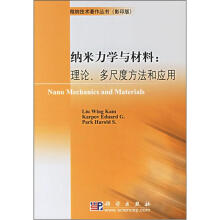1 Introduction
1.1 Potential of Nanoscale Engineering
1.2 Motivation for Multiple Scale Modeling
1.3 Educational Approach
2 Classical Molecular Dynamics
2.1 Mechanics of a System of Particles
2.2 Molecular Forces
2.3 Molecular Dynamics Applications
3 Lattice Mechanics
3.1 Elements of Lattice Symmetries
3.2 Equation of Motion of a Regular Lattice
3.3 Transforms
3.4 Standing Waves in Lattices
3.5 Green's Function Methods
3.6 Q~asi-Static Approximation
4 Methods of Thermodynamics and Statistical Mechanics
4.1 Basic Results of the Thermodynamic Method
4.2 Statistics of Multiparticle Systems in Thermodynamic Equilibrium
4.3 Numerical Heat Bath Techniques
5 Introduction to Multiple Scale Modeling
5.1 MAAD
5.2 Coarse-Grained Molecular Dynamics
5.3 Quasi-Continuum Method
5.4 CADD
5.5 Bridging Domain
6 Introduction to Bridging Scale
6.1 Bridging Scale Fundamentals
6.2 Removing Fine Scale Degrees of Freedom in Coarse Scale Region
6.3 Discussion on the Damping Kernel Technique
6.4 Cauchy-Born Rule
6.5 Virtual Atom Cluster Method
6.6 Staggered Time Integration Algorithm
6.7 Summary of Bridging Scale Equations
6.8 Discussion on the Bridging Scale Method
7 Bridging Scale Numerical Examples
7.1 Comments on Time History Kernel
7.2 1D Bridging Scale Numerical Examples
7.3 2D/3D Bridging Scale Numerical Examples
7.4 Two-Dimensional Wave Propagation
7.5 Dynamic Crack Propagation in Two Dimensions
7.6 Dynamic Crack Propagation in Three Dimensions
7.7 Virtual Atom Cluster Numerical Examples
8 Non-Nearest Neighbor MD Boundary Condition
8.1 Introduction
8.2 Theoretical Formulation in 3D
8.3 Numerical Examples: ID Wave Propagation
8.4 Time-History Kernels for FCC Gold
8.5 Conclusion for the Bridging Scale Method
9 Multiscale Methods for Material Design
9.1 Multiresolution Continuum Analysis
9.2 Multiscale Constitutive Modeling of Steels
9.3 Bid-Inspired Materials
9.4 Summary and Future Research Directions
10 Bio-Nano Interface
10.1 Introduction
10.2 Immersed Finite Element Method
10.3 Vascular Flow and Blood Rheology
10.4 Electrohydrodynamic Coupling
10.5 CNT/DNA Assembly Simulation
10.6 Cell Migration and Cell-Suhstrate Adhesion
10.7 Conclusions
Appendix A Kernel Matrices for EAM Potential
Bibliography
Index

 缺书网
缺书网 扫码进群
扫码进群





